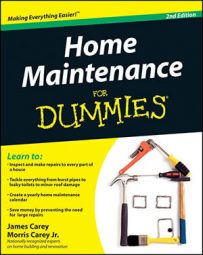Out-of-level floors are not only nuisances to walk across, but if they're severe enough, they can also become a real safety hazard. Slanted floors can also cause cracks over windows and doors or make doors and windows stick and tough to operate. Thus, by repairing your out-of-level floor, you may find the windows and doors in your home are a whole lot easier to use and last longer.
Before embarking on the floor-leveling project here, take a simpler approach first: Start by stabilizing the moisture content of the soil near the foundation. Installing gutters and downspouts (and keeping them clean), installing downspout diverters (splash blocks), installing underground drainage systems, controlling landscape irrigation, and grading soil to shed away from the foundation are all effective means of controlling excessive moisture. Depending upon the climate and temperature (based on the time of year that you take action), this passive stabilization process could take anywhere from a few weeks to the better part of a year. Try the marble test every month or so to see if your work is making a difference.
If controlling the moisture near your foundation doesn’t help, or if there was a change for the good but it simply wasn’t enough, you need to install new support posts:
Where the floor is high, place the floor jack on a block of wood and directly under the support beam.
Place it a couple of feet from the pier.
Jack up the floor slightly and knock out the existing post.
Don’t jack it up too high, just high enough to remove the post.
Place one end of a level on the high spot and the opposite end to a predetermined level area on the floor. Then, measure the distance between the bottom of the level and the level area of flooring.
This determines the length of the new post. The new post should equal the length of the old post less the measurement taken with the level.
Cut a new support post and place it between the pier and the support beam just like the one that you removed.
Slowly lower the jack until the support rests firmly on the new support post and attach the new support post to the pier and the support beam with metal connectors held with 8-penny nails.
Metal connectors are made of galvanized sheet metal fabricated to accommodate a specific-size framing member. For example, the metal connector that would be used to anchor an underpinning post to the wood cap on a pier block is called a post bottom. In the case of a four-by-four post, the post bottom is square (slightly larger than the size of the post and about 2-1/2 inches high) and has holes in all sides through which nails are driven. You drive nails through the holes in the bottom of the connector into the pier cap.
At the locations where the floor is low, the process is the same with one exception: The new support posts being installed need to be cut longer by the amount calculated with your level from above.

